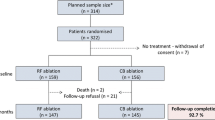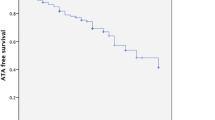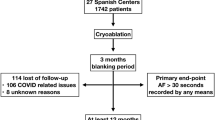Abstract
Purpose
The second-generation cryoballoon (CB-A, Arctic Front Advance, Medtronic, Minneapolis, MN, USA) has proven to be highly effective in achieving freedom from atrial fibrillation; nonetheless, the ideal number and duration of freezing cycles is still a matter of debate. We investigated the acute success, procedural complications, and clinical outcome of a single freeze strategy using the CB-A in a large, retrospective, international multicenter study.
Methods
Between January 2013 and September 2015, 818 consecutive patients (58 ± 12 years, 68% males) with drug-resistant atrial fibrillation (AF) who underwent a CB-A using a single freeze strategy were taken into consideration for our analysis.
Results
Paroxysmal AF was documented in 74.1% of the patients, while 25.9% presented with persistent AF. Additional freezes were needed in a mean 1.4 veins per patient. 0.2% of the patients experienced persistent PNP that was still documented at the last follow-up. After a median follow-up of 14 ± 8 months, taking into consideration a blanking period (BP) of 3 months, 692 patients (84.6%) were free from arrhythmia recurrence. After a single procedure, AF recurrence during BP and persistent AF were identified as predictors of clinical recurrence after BP.
Conclusions
Single freeze CB-A ablation is effective in treating drug-resistant AF and affords freedom from arrhythmia recurrences in 84.6% of patients during a 14-month follow-up. Persistent AF and recurrence during BP are predictors of arrhythmia recurrences.


Similar content being viewed by others
References
Chierchia GB, Di Giovanni G, Ciconte G, de Asmundis C, Conte G, Sieira-Moret J, et al. Second-generation cryoballoon ablation for paroxysmal atrial fibrillation: 1-year follow-up. Europace. 2014;16:639–44.
Irfan G, de Asmundis C, Mugnai G, Poelaert J, Verborgh C, Umbrain V, et al. One-year follow-up after second-generation cryoballoon ablation for atrial fibrillation in a large cohort of patients: a single-centre experience. Europace. 2016;18:987–93.
Metzner A, Reissmann B, Rausch P, Mathew S, Wohlmuth P, Tilz R, et al. One-year clinical outcome after pulmonary vein isolation using the second-generation 28-mm cryoballoon. Circ Arrhythm Electrophysiol. 2014;7:288–92.
Di Giovanni G, Wauters K, Chierchia GB, Sieira J, Levinstein M, Conte G, et al. One-year follow-up after single procedure cryoballoon ablation: a comparison between the first and second generation balloon. J Cardiovasc Electrophysiol. 2014;25:834–9.
Fürnkranz A, Bordignon S, Schmidt B, Gunawardene M, Schulte-Hahn B, Urban V, et al. Improved procedural efficacy of pulmonary vein isolation using the novel second-generation cryoballoon. J Cardiovasc Electrophysiol. 2013;24:492–7.
Ciconte G, de Asmundis C, Sieira J, Conte G, Di Giovanni G, Mugnai G, et al. Single 3-minute freeze for second-generation cryoballoon ablation: one-year follow up after pulmonary vein isolation. Heart Rhythm. 2015;12:673–80.
Ciconte G, Sieira-Moret J, Hacioglu E, Mugnai G, Di Giovanni G, Velagic V, et al. Single 3-minute versus double 4-minute freeze strategy for second-generation cryoballoon ablation: a single-center experience. J Cardiovasc Electrophysiol. 2016;27:796–803.
Wissner E, Heeger CH, Grahn H, Reissmann B, Wohlmuth P, Lemes C, et al. One-year clinical success of a ‘no-bonus’ freeze protocol using the second-generation 28 mm cryoballoon for pulmonary vein isolation. Europace. 2015;17(8):1236–40.
Medi C, Evered L, Silbert B, Teh A, Halloran K, Morton J, et al. Subtle post-procedural cognitive dysfunction after atrial fibrillation ablation. J Am Coll Cardiol. 2013;62(6):531–9.
Andrade JG, Dubuc M, Guerra PG, Landry E, Coulombe N, Leduc H, et al. Pulmonary vein isolation using a second-generation cryoballoon catheter: a randomized comparison of ablation duration and method of deflation. J Cardiovasc Electrophysiol. 2013;24:692–8.
Coulombe N, Paulin J, Su W. Improved in vivo performance of secondgeneration cryoballoon for pulmonary vein isolation. J Cardiovasc Electrophysiol. 2013;24:919–25.
Dubuc M, Roy D, Thibault B, Ducharme A, Tardif JC, Villemaire C, et al. Transvenous catheter ice mapping and cryoablation of the atrioventricular node in dogs. Pacing Clin Electrophysiol. 1999;22:1488–98.
Chierchia GB, Di Giovanni G, Sieira-Moret J, de Asmundis C, Conte G, Rodriguez-Mañero M, et al. Initial experience of three-minute freeze cycles using the second-generation cryoballoon ablation: acute and short-term procedural outcomes. J Interv Card Electrophysiol. 2014 Mar;39(2):145–51.
Miyazaki S, Hachiya H, Nakamura H, Taniguchi H, Takagi T, Hirao K, et al. Pulmonary vein isolation using a second-generation cryoballoon in patients with paroxysmal atrial fibrillation: one-year outcome using a single big-balloon 3-minute freeze technique. J Cardiovasc Electrophysiol. 2016 Dec;27(12):1375–80.
Ghosh J, Sepahpour A, Chan KH, Singarayar S, McGuire MA. Immediate balloon deflation for prevention of persistent phrenic nerve palsy during pulmonary vein isolation by balloon cryoablation. Heart Rhythm. 2013;10:646–52.
Chun KR, Fürnkranz A, Köster I, Metzner A, Tönnis T, Wohlmuth P, et al. Two versus one repeat freeze-thaw cycle(s) after cryoballoon pulmonary vein isolation: the alster extra pilot study. J Cardiovasc Electrophysiol. 2012;23(8):814–9.
Tebbenjohanns J, Höfer C, Bergmann L, Dedroogh M, Gaudin D, von Werder A, et al. Shortening of freezing cycles provides equal outcome to standard ablation procedure using second-generation 28 mm cryoballoon after 15-month follow-up. Europace. 2016;18(2):206–10.
Gage AA, Baust J. Mechanisms of tissue injury in cryosurgery. Cryobiology. 1998;37:171–86.
Lim HW, Cogert GA, Cameron CS, Cheng VY, Sandler DA. Atrioesophageal fistula during cryoballoon ablation for atrial fibrillation. J Cardiovasc Electrophysiol. 2014;25:208–13.
Kawasaki R, Gauri A, Elmouchi D, Duggal M, Bhan A. Atrioesophageal fistula complicating cryoballoon pulmonary vein isolation for paroxysmal atrial fibrillation. J Cardiovasc Electrophysiol. 2014;25:787–92.
Guhl EN, Siddoway D, Adelstein E, Bazaz R, Mendenhall GS, Nemec J, et al. Incidence and predictors of complications during cryoballoon pulmonary vein isolation for atrial fibrillation. J Am Heart Assoc. 2016;21:5(7). doi:10.1161/JAHA.116.003724.
Matsuda J, Miyazaki S, Nakamura H, Taniguchi H, Kajiyama T, Hachiya H, et al. Pulmonary vein stenosis after second-generation cryoballoon ablation. J Cardiovasc Electrophysiol. 2017;28(3):298–303.
Martí-Almor J, Jauregui-Abularach ME, Benito B, Vallès E, Bazan V, Sánchez-Font A, et al. Pulmonary hemorrhage after cryoballoon ablation for pulmonary vein isolation in the treatment of atrial fibrillation. Chest. 2014;145:156–7.
Oral H, Knight BP, Ozaydin M, Tada H, Chugh A, Hassan S, et al. Clinical significance of early recurrences of atrial fibrillation after pulmonary vein isolation. J Am Coll Cardiol. 2002;40(1):100–4.
Koyama T, Sekiguchi Y, Tada H, Arimoto T, Yamasaki H, Kuroki K, et al. Comparison of characteristics and significance of immediate versus early versus no recurrence of atrial fibrillation after catheter ablation. Am J Cardiol. 2009;103(9):1249–54.
Mugnai G, de Asmundis C, Hünük B, Ströker E, Velagic V, Moran D, et al. Second-generation cryoballoon ablation for paroxysmal atrial fibrillation: predictive role of atrial arrhythmias occurring in the blanking period on the incidence of late recurrences. Heart Rhythm. 2016;13(4):845–51.
Quan D, Huang H, Kong B, Li Q, Liao J, Wang G. Predictors of late atrial fibrillation recurrence after cryoballoon-based pulmonary vein isolation: a meta-analysis. Kardiol Pol. 2017. doi:10.5603/KP.a2016.0186.
Burstein B, Nattel S. Atrial fibrosis: mechanisms and clinical relevance in atrial fibrillation. J Am Coll Cardiol. 2008;51(8):802–9.
Verma A, Jiang CY, Betts TR, Chen J, Deisenhofer I, Mantovan R, et al., STAR AF II Investigators. Approaches to catheter ablation for persistent atrial fibrillation. N Engl J Med. 2015;372(19):1812–22.
Mugnai G, de Asmundis C, Ströker E, Hünük B, Moran D, Ruggiero D, et al. Femoral venous pressure waveform as indicator of phrenic nerve injury in the setting of second-generation cryoballoon ablation. J Cardiovasc Med (Hagerstown). 2016. doi:10.2459/JCM.0000000000000418.
Robicsek F, Duncan GD, Hawes AC, Rice HE, Harrill S, Robicsek SA. Biological thresholds of cold-induced phrenic nerve injury. J Thorac Cardiovasc Surg. 1990;99:167–70.
Dureuil B, Viires N, Pariente R, Desmonts JM, Aubier M. Effects of phrenic nerve cooling on diaphragmatic function. J Appl Physiol. 1987;63:1763–9.
Kühne M, Knecht S, Altmann D, Ammann P, Schaer B, Osswald S, et al. Validation of a novel spiral mapping catheter for real-time recordings from the pulmonary veins during cryoballoon ablation of atrial fibrillation. Heart Rhythm. 2013;10(2):241–6.
Author information
Authors and Affiliations
Corresponding author
Ethics declarations
The protocol was carried out in accordance with the ethical principles for medical research involving human subjects established by the Helsinki declaration, protecting the privacy of all the participants as well as the confidentiality of their personal information. The study was approved by the local ethics committee.
Conflict of interest
CdA, PB, SI, AA, and GBC have received consulting fees and speaker honoraria from Medtronic.
Rights and permissions
About this article
Cite this article
De Regibus, V., Iacopino, S., Abugattas, J.P. et al. Single freeze strategy with the second- generation cryballoon for atrial fibrillation: a multicenter international retrospective analysis in a large cohort of patients. J Interv Card Electrophysiol 49, 173–180 (2017). https://doi.org/10.1007/s10840-017-0254-6
Received:
Accepted:
Published:
Issue Date:
DOI: https://doi.org/10.1007/s10840-017-0254-6




